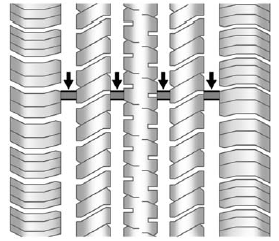When It Is Time for New Tires
Factors such as maintenance, temperatures, driving speeds, vehicle loading, and road conditions affect the wear rate of the tires.

Treadwear indicators are one way to tell when it is time for new tires.
Treadwear indicators appear when the tires have only 1.6mm (1/16 in) or less of tread remaining. See Tire Inspection on page 10‑50 and Tire Rotation on page 10‑50 for more information.
The rubber in tires ages over time.
This also applies for the spare tire, if the vehicle has one, even if it is never used. Multiple conditions including temperatures, loading conditions, and inflation pressure maintenance affect how fast aging takes place. Tires will typically need to be replaced due to wear before they may need to be replaced due to age. Consult the tire manufacturer for more information on when tires should be replaced.
Vehicle Storage
Tires age when stored normally mounted on a parked vehicle.
Park a vehicle that will be stored for at least a month in a cool, dry, clean area away from direct sunlight to slow aging. This area should be free of grease, gasoline, or other substances that can deteriorate rubber.
Parking for an extended period can cause flat spots on the tires that may result in vibrations while driving. When storing a vehicle for at least a month, remove the tires or raise the vehicle to reduce the weight from the tires.
See also:
Under the Hood
The Canyon is available with a choice of three engines, and rear- and
four-wheel-drive versions are available. Mechanical features include:
Base 185-horsepower, 2.9-liter four-cylinder makes 190 p ...
Manual Windows
Turn the hand crank on each door to manually raise or lower the manual windows. ...
Dome Lamps
The dome lamps are located in the overhead console.
They come on when any door is opened and turn off after all the doors are closed.
Turn the instrument panel brightness knob located below the dome ...





